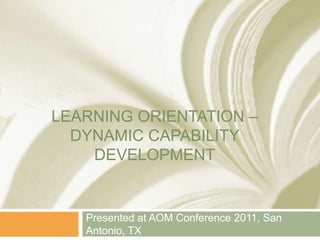
Aom 2011 Dynamic Capability Presentation
- 1. LEARNING ORIENTATION – DYNAMIC CAPABILITY DEVELOPMENT Presented at AOM Conference 2011, San Antonio, TX
- 2. The Age of Temporary Advantage Recent scholars suggest we now live in the age of temporary advantage (D’Aveni, Dagnino, & Smith, 2010) Miller (2003) suggests firms should be looking for an attainable competitive advantage
- 3. Why Dynamic Capabilities Firms continue to search for sources of creating and sustaining competitive advantage Teece, Pisano, and Shuen (1997) proposed that dynamic capabilities offer the potential such advantage
- 4. Defining Dynamic Capabilities Dynamic Capability: Teece, Pisano, and Shuen (1997) - put “dynamic” and “capability” together - Defined it as an “ability” to reconfigure internal and external “competencies” in rapidly changing environments
- 5. Defining Dynamic Capabilities Dynamic Capability: Eisenhardt and Martin (2000) - Referred to the strategic nature - Defined it as processes to reconfigure that match or even create market change.
- 6. Defining Dynamic Capabilities Dynamic Capability: Zollo and Winter (2002) - Referred to the strategic nature - Defined it as “patterns” to modify operations to create greater effectiveness. - Introduced “develop” and “developing” into their hypotheses but never defined the construct of dynamic capability development.
- 7. Defining Dynamic Capabilities Development: Zollo and Winter (2002) - Development of routines stem from (1) experience accumulation, (2) knowledge articulation, and (3) knowledge codification processes
- 8. Dynamic Capability Development Dynamic Capability Development (D.C.D.): The extent to which the members of a firm purposefully generate routines to integrate, reconfigure, gain and release resources. Note: This is a new construct.
- 9. Learning Orientation Learning Orientation (a firm level construct) has four dimensions as defined by Calantone, Cavusgil, and Zhao, (2002): (1) Shared Vision (2) Commitment to Learning (3) Intra-organizational Knowledge Sharing (4) Open Mindedness
- 10. Relationship of IC’s/DC Commitment to Learning Shared Vision Dynamic Capability Intraorganizational Development Knowledge Sharing Open-Mindedness
- 11. Commitment to Learning Defined Commitment to Learning: the extent to which an organization emphasizes learning.
- 12. Commitment to Learning – D.C.D. Penrose (1959): unknown and unused productive services immediately become of considerable importance… because they shape the scope and direction of the search for knowledge (page 77) As the search for knowledge is shaped and directed, dynamic capabilities develop.
- 13. Proposition 1 Commitment to learning is positively associated with dynamic capability development.
- 14. Shared Vision Sinkula et al. (1997) explain that a shared vision influences the direction of learning within an organization. Calantone, Cavusgil, and Zhao (2002) state that shared vision refers to an organization-wide focus on learning.
- 15. Shared Vision Defined Shared Vision: the extent to which an organization promotes learning focused on its desired future state.
- 16. Shared Vision – D.C.D. Suchman’s (1995): legitimacy is a generalized perception or assumption that the actions of an entity are desirable, proper, or appropriate within some socially constructed system of norms, values, beliefs, and definitions (page 574). The shared vision of the firm is such a socially constructed system. As an organization promotes learning based on its shared vision, it will begin to develop strengths and competences (Calantone et al. 2002). Some of those strengths and competences will develop as dynamic capabilities.
- 17. Proposition 2 Shared vision is positively associated with dynamic capability development.
- 18. Intra-organizational Knowledge Sharing Defined Intra-organizational Knowledge Sharing: the extent to which an organization promotes learning focused on its desired future state.
- 19. Proposition 3 Intra-organizational knowledge sharing is positively associated with dynamic capability development.
- 20. Open-Mindedness Defined Open-Mindedness: The extent to which an organization is willing to proactively question its past routines, assumptions, and beliefs.
- 21. Open Mindedness – D.C.D. As firms regularly reconsider their operations, they are more likely to develop routines to consider how they might reconfigure their resources. In other words, open mindedness would lead dynamic capability development.
- 22. Proposition 4 Open-mindedness is positively associated with dynamic capability development.
- 23. Dynamic Capabilities and Sustainable Competitive Advantage Critics have suggested that the resource-based view implies infinite regress, but a recent review of these critiques (Kraaijenbrink, Spender, & Groen, 2010) concluded that within a few levels of abstraction, such extension loses its connection with reality. Instead, the importance of such higher-order capabilities (i.e., dynamic capabilities) is their interaction with lower order capabilities.
- 24. Dynamic Capabilities and Sustainable Competitive Advantage Teece (2007) refers to such interactions as metacompetences, which Kraaijenbrink and colleagues (2010) liken to single and double-loop learning. We suggest that members of a firm apply the elements of a learning orientation to organize dynamic capabilities more effectively. Improving a lower-order competence could then improve firm’s advantage.
- 25. Proposition 5 Dynamic capabilities organized under the learning orientation construct will be positively associated with sustainable competitive advantage.
- 26. Implications for Scholars Previously, work on dynamic capabilities has been focused at the firm level. Here we acknowledge that such capabilities must exist within the members of a firm. Few articles have considered where dynamic capabilities originate. In this article, we suggest that they stem from the organized learning of a firm.
- 27. Implications for Practice Change in any environment is inevitable, and in today’s world, it is fairly constant. For organizations, change must be managed to reduce and avoid waste of resources. To understand the changing environment, organizations must commit to learning. By organizing the learning of a firm, members can develop routines to make change more effective,
